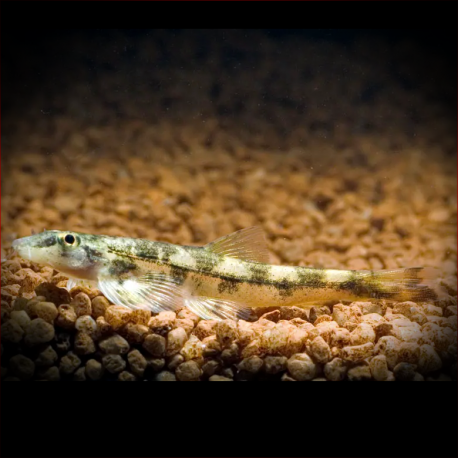More info
Datasheet
| Minimum Tank Size | 60 litres / 15.85 US gallons |
| Maximum Size | 3.6cm / 1.42inches |
| Temperature | 20°C / 68.00°F - 25.5°C / 77.90°F |
| Hardness | 1.01dgH / 18ppm - 12.05dgH / 215ppm |
| pH | 6.0-7.5 |
General Description
Homalopteroides Nebulosus, commonly known as the Lizard Loach, is a species within the family Balitoridae. This poorly-known aquarium fish is distinguished by its 36-40 lateral line scales, dark brown stripe along the lateral line, and unique mouth morphology.
Aquarium Setup
The ideal tank setup for H. Nebulosus requires clean, well-oxygenated water with a turnover of 10-15 times per hour. The use of an over-sized filter is recommended, along with the incorporation of gravel, sand, water-worn rocks, pebbles, driftwood roots, and aquatic plants like Microsorum, Crinum, and Anubias spp.
Behaviour
Despite not being aggressive, the Lizard Loach is best kept in groups of six or more to encourage bold behavior. It thrives in aggregations and displays interesting interactions between individuals. Compatibility with tankmates needs careful consideration due to its specific requirements.
Feeding and Diet
H. Nebulosus is a micropredator, feeding on small crustaceans, insect larvae, and other invertebrates. In captivity, live or frozen food such as Daphnia, Artemia, and bloodworms are essential for optimal health. Balitorids are known to struggle with emaciation, requiring a consistent and suitable source of food to recover.
Reproduction & Dimorphism
While the breeding habits of H. Nebulosus are not documented in captivity, it is presumed to be a seasonal spawner in its natural habitat. Sexually mature females are slightly larger and fuller-bodied compared to males.
Habitat and Distribution
Found in swiftly-flowing streams with clear, oxygen-saturated water, H. Nebulosus originates from the Sok River in northern Peninsular Malaysia. It has also been recorded in Malaysian and Indonesian parts of Borneo and the Natuna Islands off Borneo's western tip.
Etymology: The genus name Homalopteroides is derived from the ancient Greek for "form" or "likeness," while the species epithet Nebulosus stems from Latin, denoting "cloudy" or "dark."

